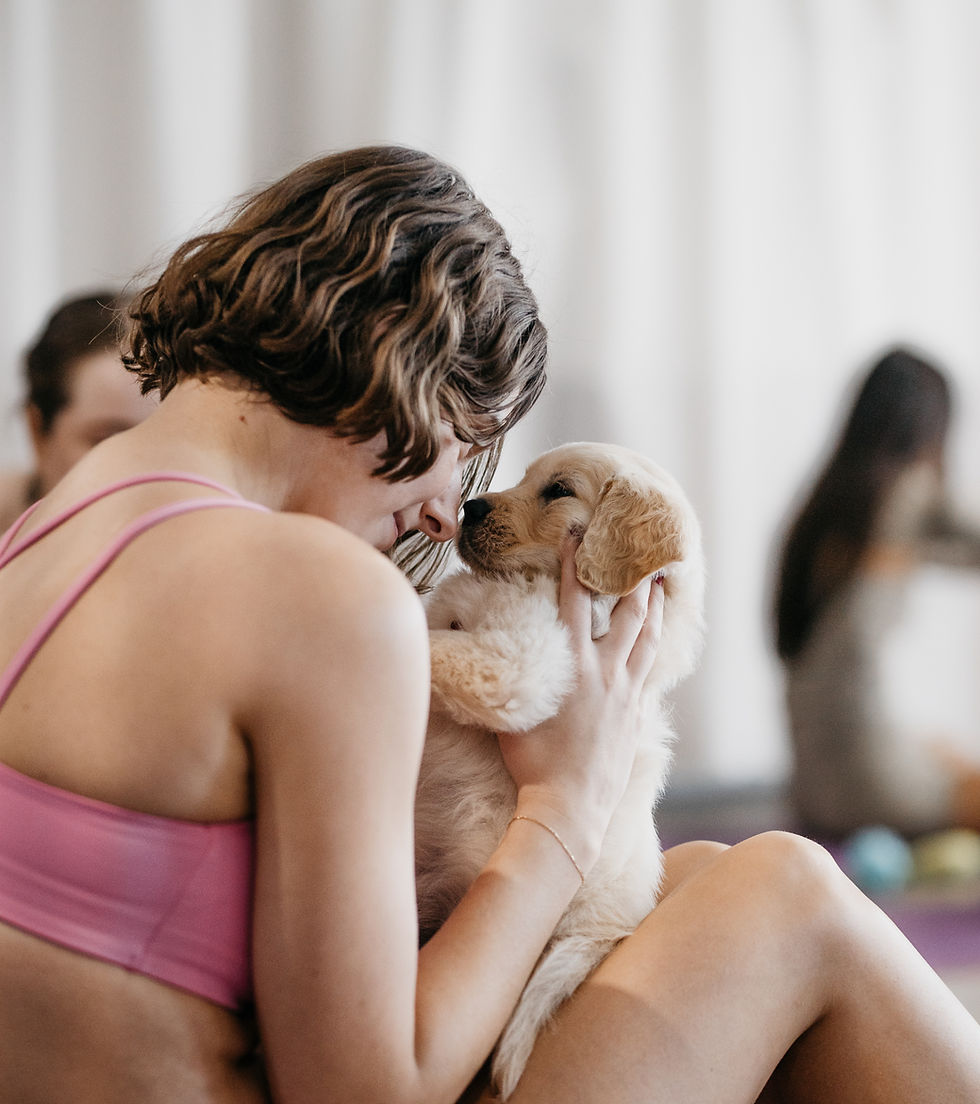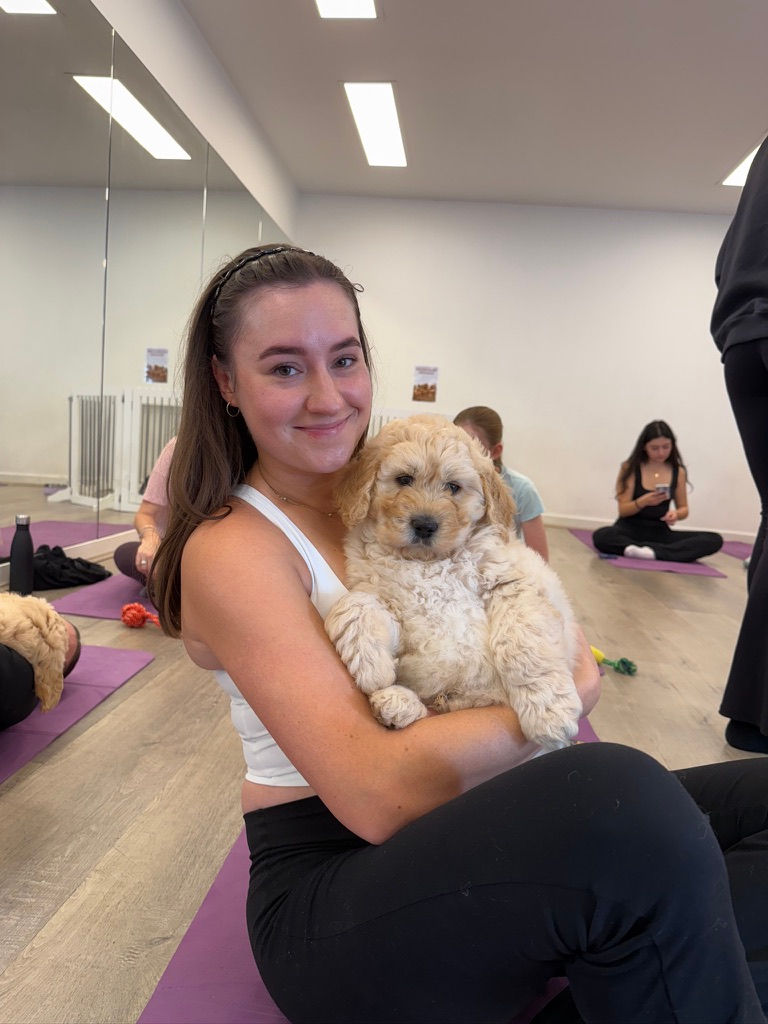Puppy Yoga Ethics: Putting Puppy Welfare First
- Harry McCann

- 11 hours ago
- 5 min read
Puppy yoga is adored because it combines feel-good movement with the unfiltered joy of being around puppies, where it’s actually more beneficial for the puppies through intentional socialisation, when done right. On the surface it seems fun and simple, but the truth is that young dogs are still growing and need a lot of care. Their wellbeing depends on proper rest, comfort, gentle handling, and a safe environment. Without these, the experience can quickly become stressful for the puppies instead of something positive.
How classes are run is not just a small detail, it should be the beating heart of the event. Puppies are not props, they are living little beings that deserve respect and care. When their needs are put first, everybody benefits. The people in the room leave happy and relaxed, and the puppies walk away with positive experiences that help them grow into confident, well rounded dogs.
If you want to take part in Puppy Yoga with an organisation that truly puts the puppies first, where human enjoyment is intended to be the bi-product of a puppy-first experience, Yoga Paws is regarded widely across Australia as the leader of animal welfare.
So, how do you know if a puppy yoga class is being run with the right care and standards in place like Yoga Paws? These indicators signs are a good way to tell:

(1) Appropriate breaks in between sessions
When we were shaping the concept for Yoga Paws, we spent a lot of time researching how much rest puppies really need between interactions. Human contact is great for socialisation, but it is also mentally stimulating and physically tiring for young dogs. To balance this out, puppies need proper nap time to decompress. At first, we considered 45 minute breaks between sessions, as this is the minimum recommended by experts. But once we factored in the extra 15 minutes needed to vacuum and sanitise the studio, we realised 60 minute breaks were the only way to do it properly.
For the puppies’ sake, 45 minutes should be seen as the bare minimum. In reality, 60 minutes is far more appropriate. Sadly, we have even received reports of classes being run with only 15 minute breaks in between 60-minute sessions. That is not even enough time for guests to leave, the next group to arrive, and the space to be properly cleaned. Vacuuming and sanitising alone takes 15 minutes, and disinfectants need additional time to settle and dry before the area is safe again. In that kind of schedule, the puppies could end up awake and overstimulated for six or more hours straight, without either the proper rest or a truly clean environment.
When booking a puppy yoga session, it is worth checking the timetable and paying attention to the breaks given between classes. This simple detail speaks volumes about how seriously the puppies’ welfare is being taken.
(2) Clean and well maintained facilities
Cleanliness is non negotiable when it comes to puppy yoga. Puppies are curious, playful, and still building their immune systems, which means they are far more vulnerable to germs than adult dogs. After every session, the space needs to be vacuumed and sanitised with vet grade products that are proven safe for animals, such as F10. This is not about making the studio look tidy for the next group, it is about reducing the risk of illness and keeping the environment safe.
Fresh mats, clean bedding, and disinfected surfaces should be the baseline. If a studio is rushing classes back to back, chances are the space is not being cleaned properly in between, and that can put the puppies at risk. A properly run session leaves the environment just as healthy as the puppies in it.

(3) Trained Staff
Another key sign of an ethical puppy yoga class is having trained staff present whose job is to care for the puppies. Their role is not to lead the yoga, but to keep a close eye on the animals, make sure they are safe, and step in the moment a puppy looks tired or overwhelmed. At least two dedicated staff members should always be present, supervising interactions and guiding participants on how to handle the puppies gently and correctly.
Before the class even begins, staff should walk everyone through the basics, like how to support a puppy’s spine, never standing up while holding them, and respecting when a puppy wants to return to the pen. Without this support, puppies can easily be mishandled or overstimulated. With it, they are given the freedom to explore and interact on their own terms, while participants learn how to engage with them in a way that is kind and safe.
(4) Access to Water
Puppies, just like people, need to stay hydrated throughout the day. With all the excitement of playing and socialising, they can tire quickly, so it is important they always have clean bowls of fresh water within reach. Water should be available before, during, and after every class, and topped up regularly. It is a simple step, but it makes a big difference in keeping puppies comfortable and healthy during their time in the studio.

(5) Forcing interactions
A big part of keeping puppy yoga ethical is making sure that interactions are never forced. At Yoga Paws we follow a puppies-on-their-own-accord policy, which means the puppies are free to choose how much or how little they want to engage. If a puppy wanders back to the pen mid-session, we may gently bring them back out once, often because they were distracted by something like chewing on the pen wall (apparently it is super tasty), but if they return again, as rare as this is, that is their choice, and they can stay in the pen and rest without any pressure to rejoin.
This approach keeps the experience positive for every puppy, allowing them to socialise, play, or simply take time out when they need it.
Ultimately:
Puppy yoga has the potential to be a truly positive experience, but only when the puppies’ wellbeing is at the centre of everything. By looking for simple signs like 45-60 minute breaks, clean facilities, trained staff, fresh water, and interactions that happen on the puppies’ terms, you can feel confident the class is being run responsibly. When these standards are met, the result is an experience that feels good for people and gives puppies the safe, supportive environment they need to grow and thrive.
At the end of the day, it does not matter if you come to us or another provider. What matters most is that the puppies are treated with the care they deserve. Just make sure wherever you go, the organisation is putting their welfare first!





